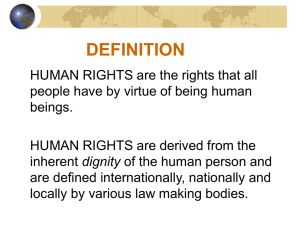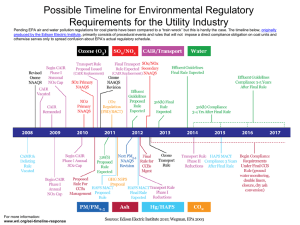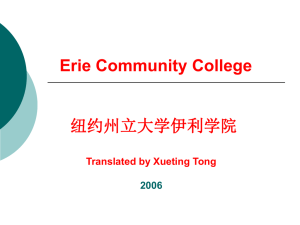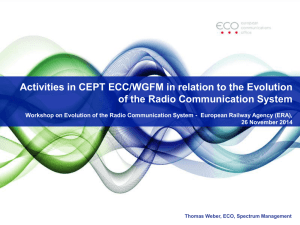DRAFT DRAFT Draft ECC REPORT XXX Page DRAFT Draft ECC
advertisement
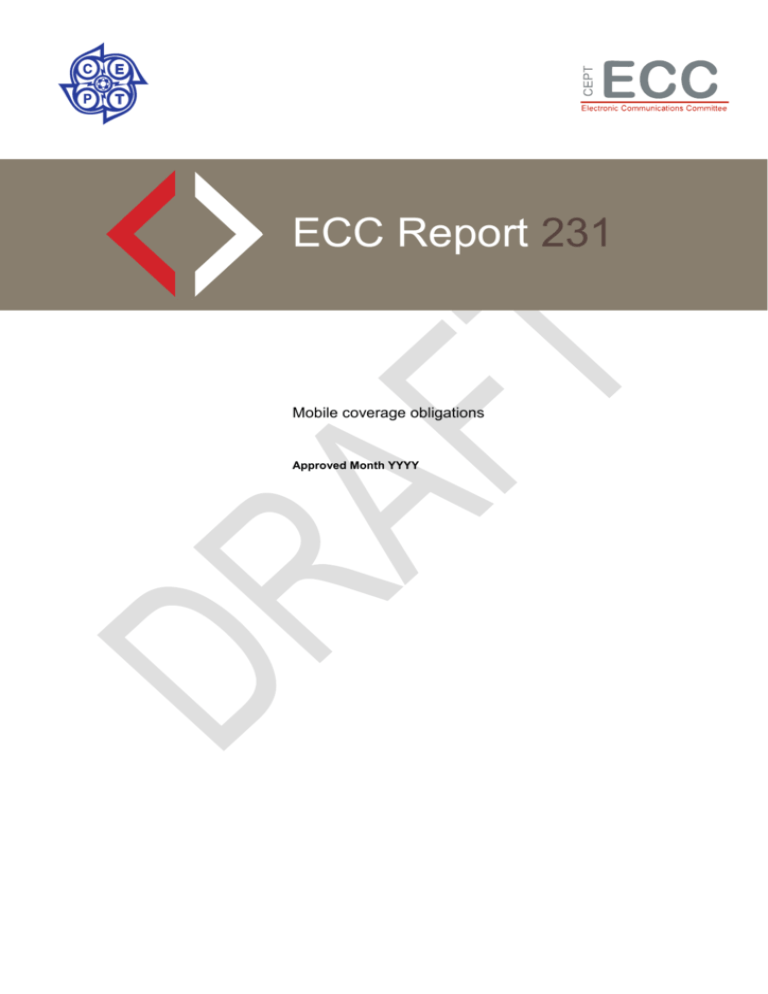
Draft report on Coverage obligations ECC Report 231 Mobile coverage obligations Approved Month YYYY DRAFT ECC REPORT 231 - Page 2 0 EXECUTIVE SUMMARY In 2014, ECC had noted the need to assess the various coverage obligations in force and how they are controlled/assessed (measurement and/or simulation). For that ECC invited ECC PT1 to develop a questionnaire on coverage obligations and how they are controlled (measurement and/or simulation). 29 administrations1 have replied to the questionnaire including a number of non EU countries indicating a significant interest in the subject. A summary of responses was drafted by ECO, see ANNEX 3:. The previous results of the questionnaire from RSPG/BEREC on coverage obligations were also used in the development of this report. The analysis carried out in this Report sought to take into account the following: Overview of the current situation regarding coverage obligations in CEPT identifying the types of coverages in practice; Analysis of the current criteria’s for the availability of coverage per type of service; Analysis of the enforcement of coverage obligations for Rights of Use/licences to use the spectrum; Additional possibility for future practice. Based on the analysis done in this report, many different approaches have been chosen throughout the CEPT concerning coverage obligations and relevant enforcement measures. It is largely inappropriate to seek to establish one harmonised approach to coverage obligations and enforcement, bearing in mind that the definitions and enforcement of coverage obligations are to be considered a national matter. CEPT administrations could cooperate on bi-lateral basis based on commonalities which could be identified in this deliverable. 1 In addition one administration replied that is was unable to answer the questions for the time being. DRAFT ECC REPORT 231 - Page 3 TABLE OF CONTENTS 0 EXECUTIVE SUMMARY ............................................................................................................................ 2 1 INTRODUCTION ......................................................................................................................................... 5 2 COVERAGE OBLIGATIONS AND ASSSOCIATED CRITERIA ............................................................... 7 2.1 Types of coverage obligation ............................................................................................................ 7 2.2 Criteria associated to coverage obligations ...................................................................................... 8 2.2.1 Criteria for voice coverage ....................................................................................................... 8 2.2.2 Criteria for data coverage ........................................................................................................ 9 3 ENFORCEMENT OF SERVICE (VOICE AND DATA) COVERAGE ....................................................... 10 3.1 Supervision methods currently in use ............................................................................................. 10 3.1.1 Operators provide information on their network coverage .................................................... 10 3.1.2 Theoretical studies run by the administrations/NRA ............................................................. 10 3.1.3 Field measurements .............................................................................................................. 11 4 ADDITIONAL POSSIBILITY FOR FUTURE PRACTICE ......................................................................... 12 4.1 Crowdsourcing to verify mobile coverage ....................................................................................... 12 5 CRITERIA AND ENFORCEMENT............................................................................................................ 13 6 CONCLUSIONS ........................................................................................................................................ 14 ANNEX 1: STATISTICAL ANALYSIS OF THE QUESTIONNAIRE ............................................................... 15 ANNEX 2: AN EXAMPLE OF SMARTPHONE APPLICATION TO GATHER CROWDSOURCED DATA .. 17 ANNEX 3: SUMMARY OF THE QUESTIONNAIRE ....................................................................................... 19 ANNEX 4: LIST OF REFERENCE .................................................................................................................. 20 DRAFT ECC REPORT 231 - Page 4 LIST OF ABBREVIATIONS Abbreviation Explanation BEREC CEPT CEPT CPICH dBµV/m dBm DTM Body of European Regulators for Electronic Communications European Conference of Postal and Telecommunications Administrations European Conference of Postal and Telecommunications Administrations Common pilot channel Decibel above 1 microvolt per meter Decibel referenced to milliwatts Digital terrain model ECC ECC ECC PT1 EIRP GIS GSM Electronic Communications Committee Electronic Communications Committee ECC Project Team 1 - IMT matters Effective isotropic radiated power Geographic information system Global System for Mobile Communications ITU JRC kbit/s LTE Mbit/s MFCN International Telecommunication Union Joint Research Council kilobit per second Long Term Evolution Megabit per second Mobile/fixed communications networks NRA RSCP RSPG RSRP RxLEV RxQUAL SINR National regulatory authority Received signal code power Radio Spectrum Policy Group Reference signal received power Received signal level Received signal quality Signal-to-interference-plus-noise ratio UMTS WCDMA WG FM Universal Mobile Telecommunications System Wide Code Division Multiple Access Working Group Frequency Management DRAFT ECC REPORT 231 - Page 5 1 INTRODUCTION In 2011 BEREC/RSPG issued a questionnaire on ‘Economic and social value of spectrum’. The purpose of that survey was to collect information on the assignment process in a number of WAPECS frequency bands. The answers to the questionnaire did not contain any information on the current field strength or signal level necessary to achieve the required coverage in mobile telephony/data networks. From the answers to the BEREC/RSPG questionnaire it can be concluded that there is a large variation in the coverage and service obligations from one country to another, even from one frequency band to another, and they indicate a large variation in the choice of monitoring/enforcement. In 2014, ECC had noted the need to assess the various coverage obligations in force and how they are controlled/assessed (measurement and/or simulation). In the end the collected information could help to reach a best practice or a common understanding of the criteria to establish whether a certain area is considered to be covered. For that ECC launched a questionnaire to collect information about the current coverage obligations and how these obligations are enforced in public cellular networks (800 MHz, 900 MHz, 1800 MHz, 2 GHz, 2.6 GHz) throughout the CEPT countries 29 administrations2 have replied to the questionnaire including a number of non EU countries (see Annex 4) showing evidence of a significant interest in the subject. A summary of responses was drafted by ECO, see ANNEX 3:. The previous results of the questionnaire from RSPG/BEREC on coverage obligations were also used in the development of this report. From the answers to the ECC questionnaire it can be understood that the conclusions from the BEREC/RSPG questionnaire remain valid. In many European countries coverage requirements/obligations are included in the Rights of Use (or licence conditions) of the public mobile networks operators but not the criteria to service coverage (e.g. signal strength). Furthermore, as there is no harmonisation for coverage, different coverage requirements/obligations and criteria’s are used in different countries. The same technologies and the same type of network equipment and terminals are used, but the national context might lead to different needs (for instance, importance of the indoor coverage in some countries, small interest of geographical coverage in countries with large area uninhabited) and coverage obligations, which could also respond to national policy objectives. Additionally there is a growing demand in some countries to provide this kind of information to end-users, especially when certain requirements (data rates, indoor coverage etc.) are included in the Rights of Use (or licence conditions) of the public mobile networks operators. Describing the different practices on how coverage is defined and assessed among the CEPT countries could help administrations in supervision of the Rights of Use/licence conditions. Various deliverables on coverage measurement are already available in ECC, such as the ECC Report 103 on UMTS coverage measurements that describes a method to measure UMTS coverage, and ECC Report 118 with a monitoring methodology to assess the performance of GSM networks. Both methodologies are based on practical measurements in the field given information of the coverage and some indicators about the quality of service of the network at specific points and at specific moments on time. ECC has identified the need to develop a similar report on LTE measurements as the ECC report already available on UMTS that is under development. Therefore, the analysis carried out in this Report sought to take into account the following: 2 Overview of the current situation regarding coverage obligations in CEPT identifying the types of coverage obligations in practice; Analysis of the current criteria’s for the availability of coverage per type of service; Analysis of the enforcement of coverage obligations for Rights of Use/licences to use the spectrum; Make suggestions for future practice. In addition one administration replied that is was unable to answer the questions for the time being. DRAFT ECC REPORT 231 - Page 6 The report is structured as follows: In Section 2, different types of coverage obligations (voice coverage and data coverage) are introduced as well as the relevant observations of the responses to questionnaire on these obligations; In Section 3, enforcement related topics are highlighted; In Section 4, an additional possibility for future practice is shown; In Chapter 5, conclusions are drawn; In Annex 2, the summary of responses are provided statistically; In Annex 3, an example of smartphone application to gather crowdsourced performance data is presented. Annex 4, an embedded zip-file: SUMMARY - ECC PT1(14)031_A08_Questionnaire coverage obligations - rev2.zip DRAFT ECC REPORT 231 - Page 7 2 COVERAGE OBLIGATIONS AND ASSSOCIATED CRITERIA This section includes an overview of the current situation regarding coverage obligations in CEPT countries which responded to the questionnaire on coverage obligations. The results shown in this section are based on the answers from the questionnaire available in ANNEX 3: (some statistical analysis of the questionnaire is available in Annex 2) launched by ECC PT1 as well as the RSPG/BEREC questionnaire on ‘Economic and social value of spectrum’. A quick analysis of the answers shows that of the 29 answers: 24 administrations have imposed coverage obligations regarding the voice service in one or more frequency bands. 25 administrations have imposed coverage obligations regarding the data service in one or more frequency bands. The following sections are describing in more detail the types of coverage obligations used in the CEPT administrations. 2.1 TYPES OF COVERAGE OBLIGATION A vast majority of the CEPT administrations have imposed some sort of coverage obligations through Rights of Use/licences to use spectrum for public mobile communications. Some have set up coverage obligations for the voice service, some for the data service and some for both. Two main types of coverage obligations can be extracted from the questionnaire: Population coverage: the operator needs to cover a percentage of the population; Area coverage: the operator needs to cover a percentage of the territory. According to the answers to the questionnaire, population coverage obligations are more commonly used than area ones and in some countries both apply. The coverage obligations can be gradual through time. For example, in Belgium for the 800 MHz band, the coverage obligation, that does not include the voice service, is: 30% of population 2 years after obtaining licence; 70% of population 4 years after obtaining licence; 98% of population 6 years after obtaining licence. The coverage obligations can also be combined, like in Denmark for the 800 MHz band, where for one licensee the following obligation, 98 % geographical coverage and 99.8 % population coverage with other specific terms has been assigned. However specific assumptions for the coverage obligations, like indoor or outdoor coverage, are in majority of cases not defined in the Right of Use/licence conditions. Some countries have coverage obligations than can be provided with the combination of frequency bands or technologies in use. This applies mostly to data services (800 MHz, 900 MHz, 1800 MHz, 2100 MHz and 2600 MHz or a subset of these bands) but it can also apply to voice services. For example, Portugal has now its obligations by service, voice and data, and can be fulfilled using all the frequencies/technologies that are allocated/authorised for the mobile operators. In opposition, some countries have specific coverage obligations per frequency band or technology in use. DRAFT ECC REPORT 231 - Page 8 It should be noted that the coverage obligations can be different from one licensee to another in the same country. For example in Finland there are two different coverage obligation sets at 800 MHz frequency band, one has higher obligations compared to two other licences: The mobile network has to cover 95 percent of the population of mainland Finland within three years of the license period, and 99 per cent of the mainland of Finland's population within five years of the license period. Two other mobile networks have to cover 97 percent of the population of mainland Finland within five years of the license period begins. This is due to auction rules, also certain roll-out restrictions in coordination agreements with neighbouring countries and the protection of the use of DTTB channel 60 in Finland. In some cases the coverage obligations are already considered fulfilled, for example for the frequency bands allocated to MFCN a long time ago (e.g. the 900 MHz band and 1800 MHz frequency bands). On the other hand, some administrations have developed quite strong coverage obligations on the frequency bands also when licences are renewed or re-auctioned, however in these cases usually obligations can be met by combining coverage areas of different frequency ranges using same technology. This is also due to universal service obligation (e.g. voice and data) that needs to be fulfilled for voice telephony service, which is in some cases nowadays provided via mobile networks. Some administrations can develop some specific coverage obligations to respond to national demand. For example: In Portugal, each mobile operator has the obligation to cover 160 parishes geographically and these coverage obligations only can be meet with the use of frequencies in the 800 MHz and 900 MHz bands (the operator should communicate if they intend to use the 900 MHz band); In France, In order to maximize the geographical coverage, “area of high priority” has been defined, area with a low density of population (the area represents 63% of the territory and 18 % of the population) for the LTE deployment. The operators have an obligation to cover a certain percentage (population) of this area (40 % in January 2017 and 90 % in January 2022). In order to help this deployment, the administrations facilitate the association of different operators for the installation of base stations (one base station for several operators). Some similar obligation has been developed for GSM and UMTS. It was indicated that in some cases issued Rights of Use/licenses contain also more general obligations related to coverage obligations e.g. obligations to obtain a certain amount of a radio frequency assignment use permits, obligations to install a certain number of base stations per predetermined territory (square kilometres). 2.2 CRITERIA ASSOCIATED TO COVERAGE OBLIGATIONS Section 3.1 of this report gives an overview of the possible coverage obligations currently imposed by service through Rights of use/licencing schemes in CEPT countries which answered to the questionnaire. Following sections analyses the current criteria for the availability of coverage per type of service, voice and data, reported in the survey. 2.2.1 Criteria for voice coverage The answers to the questionnaire indicate various kinds of criteria to be fulfilled for voice coverage. The different criteria possible that were described in the answers to the questionnaire are: The ability to make a phone call: for example in France, the criteria for voice coverage is the ability to make a one-minute phone call, outside of buildings, walking with pedestrian speed; The advantage of this criterion is that it gives a realistic usability for defining the coverage. The field strength: the answers to the questionnaire give a range from 38 to 58 dBµV/m. Some additional prerequisites can be given such as the height above ground (from 1.5 to 1.7 m) and a probability at cell edge (from 50 to 75 %); This criterion gives the opportunity to verify easily the voice coverage, but also to enable the administrations to make some calculation for a theoretical coverage. It links directly the field DRAFT ECC REPORT 231 - Page 9 strength to the voice coverage. In reality this connection may not be that easy as other parameters such as the cell load for example might have an impact on the possibility to make a phone call. The signal strength: the answers to the questionnaire give a range from -106 to -75 dBm. Some additional prerequisites can be given such as the height above ground (from 1.7 to 3 m) and a probability of cell load (30% in the 2.1 GHz band); Same remarks as for the field strength. Quality measurement for voice service: for example a value of RxQUAL ≤ 4 is defined in one CEPT country; According the ECC Report 118 RxQUAL value is used together with a certain RxLEV value during the measurement as a decision threshold to define if locations are covered or not e.g. RxLEV≥ 18 (≥ -92 dBm) and RxQUAL ≤ 4 [1]. A specific bitrate as an indication/criterion for voice coverage: the answers to the questionnaire give a range from 12.2 to 144 kbps. The condition to be outdoors is given as an additional prerequisite. The bitrate, as the ability to make a phone call, is a criterion that is realistic but which is harder to use in practice to calculate the coverage of an operator. A majority of administrations use the field strength or signal strength as criteria to evaluate the availability of voice coverage. In general those administrations which are using signal strength as criteria have defined a higher value for GSM than for UMTS. 2.2.2 Criteria for data coverage The answers to the questionnaire indicate various kinds of criteria to be fulfilled for data coverage. In many cases a bitrate is defined but not all answers provide all the necessary prerequisites. Different criteria possible were described in the answers to the questionnaire. Maximum theoretical data rate: for example in France, the maximum theoretical data rate has to be at least 60 Mbit/s on the downlink in bands where LTE technology is assigned. Downlink data rate: a majority of administrations define a minimum downlink data rate to achieve. Different values are given, from 144 kbps to 30 Mbps for broadband frequency bands, lower values are given for narrowband frequency bands. Some administration make these obligations evolve with time, asking an initial downlink data rate, and increasing it after a number of years; Some administrations answered that as a condition in the licensee, there is an obligation for some area to be covered with a higher downlink data rate than others. For example in Austria, where it is 2 Mbit/s downlink and 0.5 Mbit/s uplink for specific municipalities, and 1 Mbit/s downlink and 0.25 Mbit/s for the rest; It is also possible to take into account the variation through the day. For example Iceland asks for downlink coverage: 10 Mbps (sometime during 24 hours), 3.85 Mbps (24 hour average) and 2.5 Mbps (average 3 hours peak time) within 4 years after obtaining licence. Some administrations asked for a minimum of population to be covered with a specific minimum data rate, some required coverage of specific location before extending the coverage to other places; The term outdoor coverage is also used in some answers to the questionnaire; Limit values for RSRP (Reference signal received power) and SINR (Signal-to-interference-plus-noise ratio) are also used. In Czech Republic, for the LTE 800 MHz, the limit value for RSRP is -109 dBm (outdoor) and for SINR is 5 dB. The different criteria (population, evolution through time, location specificity, etc.) can be combined in order to give more flexibility to administrations and to adapt the obligations to the country needs. DRAFT ECC REPORT 231 - Page 10 3 ENFORCEMENT OF SERVICE (VOICE AND DATA) COVERAGE The majority of countries didn’t define a common set of parameters agreed both by the regulator and by the mobile operators to check the service coverage. An exception can be highlighted as United Kingdom defined a verification methodology for assessment of the coverage, included in the Rights of Use of the mobile operators, where assumptions like the propagation model to be used in the calculations, the population distribution model, the terrain database, etc. are included. 3.1 SUPERVISION METHODS CURRENTLY IN USE The answers to the questionnaire describe a broad variety of methods for supervision of compliance of the coverage obligations imposed. In the questionnaire, four main methods were listed as possible supervision techniques, and are described in the following sections. 3.1.1 Operators provide information on their network coverage Some administrations ask or require the mobile operators to report on their network coverage and how there are fulfilling the obligations. The administrations which have specified periodic information specified that operators need to provide annual information on their network coverage. In some countries this information needs to be provided on band-by-band and even technology basis. It is not clear in the answers to the questionnaire how they validate the coverage data sent by the mobile operators, but theoretical studies or field measurements (respectively section 4.1.2 and 4.1.3) could be used to confirm the information from the operators. 3.1.2 Theoretical studies run by the administrations/NRA Administrations can decide to run some theoretical calculations to assess the network coverages of the different mobile operators based on some technical information provided by the operator. These studies can determine either the population or/and the territory coverage. An example of a list of information needed is given below, based on the data given by Slovenia and Latvia in the questionnaire, in order to compute the coverage: the locations of the base stations in accordance with a specified geographical projection / coordinates of base station (degrees); indication of site name, network name, network type; antenna height of base station and effective antenna height above ground level in meters; transmitting frequency; For each sector: azimuth – direction (degrees); horizontal / vertical 3 dB beamwidth (degrees) / antenna type and diagram; combined mechanical and electrical downtilt (degrees); the effective isotropic radiated power EIRP / effective radiated power ERP (dBW); antenna gain (dBi); an indication of the frequency blocks used in each cell (sector); a map with base station locations and covered areas (GIS / GEO TIFF format, vector graphics, defined by the NRA in cooperation with each operator); a list of raster cells covered and the coverage level calculated on that basis It is then up to the administration/NRA to compute the theoretical coverage based on different assumptions. For example a possible list of parameters to define: a propagation model lognormal location variation with a specified standard deviation; DRAFT ECC REPORT 231 - Page 11 a specified terrain database (DTM); a specified clutter database; specified population locations and settlement identifiers; specified use equipment noise figure and antenna gain; theoretical base station antenna azimuth and elevation radiation patterns; network load; time and location probability; received signal strength or field strength level; antenna receiver height. It should be noted that this type of theoretical studies require specific tool, particular expertise and is generally expensive. In some countries, these kind of theoretical studies are verified by spot or field measurements in order to estimate the reliability of the simulation. It can be highlighted that United Kingdom defined a verification methodology for assessment of the coverage, included in the Rights of Use of the mobile operators, where assumptions like the propagation model to be used in the calculations, the population distribution model, the terrain database, etc. are included. 3.1.3 Field measurements The administrations/NRA can conduct tests on the license holder’s network and measure the coverage and/or the quality of service at times and places of its choice in order to verify that the submitted information regarding base stations and coverage is an accurate representation of the current state of the license holder’s network. These tests can be intended to verify for example the base station parameters, level of field strength and quality of service at some end users locations. DRAFT ECC REPORT 231 - Page 12 4 4.1 ADDITIONAL POSSIBILITY FOR FUTURE PRACTICE CROWDSOURCING TO VERIFY MOBILE COVERAGE One administration has mentioned the idea of using a smartphone app to log signal strength and coordinates for further analysis. One example can found at http://opensignal.com/. There are also a number of applications that perform measurements on network speeds (uplink/downlink) on various methods, most usually only top speed for both directions is given as a result. More advanced methods contain, recognition of terminal type, location, network type, average speeds, see https://www.netradar.org/en. A more detailed example of the system requirements can be found at ANNEX 2:. This method needs further investigation and the methodology they use to assess the coverage of the network in specific points needs to be clarified. The disadvantage of this methodology, as well as the field measurements to measure the coverage and/or QoS of the mobile network, is that the information is only available at locations where participating mobile phones exist and does not give an overall overview of the network coverage. The advantage of this methodology is that with “sufficient” measurements at the same specific location, it will be possible, with time, to have a real shape of the network at that specific location. It should also be noted that the Joint Research Center (JRC) is working on an application which seeks to crowdsource spectrum monitoring, by early 2015 [2]. It shall be mentioned that ECC expressed a statement on this new form of monitoring application further to a workshop on this new form of monitoring spectrum3. 3 http://www.cept.org/ecc/groups/ecc/client/introduction/ecc-statement-on-spectrum-occupancy-workshop DRAFT ECC REPORT 231 - Page 13 5 CRITERIA AND ENFORCEMENT Criteria and enforcement are related as the enforcement defines the methodology to use to assess the criteria defined for service coverage. In principle the criteria for assess the availability of voice coverage could be easy to confirm. If it is possible to make a phone call there is coverage and from section 4.1 this can in theory be translated into a field or signal strength, but not for the cases where there is signal strength but also co-channel interference (e.g. in GSM the availability of signal doesn’t mean availability to make a voice call because it is possible to have cochannel interference or the channels can be full occupied by other users). Additionally, if a theoretical study is done, where there is a need to define the assumptions including the propagation model chosen, the availability of the needed signal calculated by the tool in a specific location to make a voice call does not mean that in reality in that location the needed signal to make a call phone will be available. Additionally, it should be noted that administrations do not agree to a single value to be used in their coverage voice obligations. In the case of data coverage it is just as easy to require a certain bitrate. High signal strength does not guarantee a high bitrate itself, for example high cell load, high speed user (in train/highway) will influence the available bitrate and end-user experience. However, with theoretical studies and with some assumptions (e.g. the available bandwidth is all allocated to one user per cell) it would be possible to determine some coverage predictions for different bit rates but, that would not correspond exactly to the reality. This means that theoretically speaking, even only with theoretical studies, the calculation of the data service is more difficult than for the voice service. Concerning the tolerance (margin allowed for coverage obligations) compliance established by the administration from the answers received to the questionnaire it can be concluded that the majority of administrations does not establish a tolerance. DRAFT ECC REPORT 231 - Page 14 6 CONCLUSIONS Based on responses to questionnaire on coverage obligations, this report describes various approaches in force coverage of obligations laid out in licences to use spectrum today. A number of different ways to define the criteria for both voice and data coverage is implemented. In consequence number of different approaches to enforcement them has been identified in this report. Based on the analysis done in this report, many different approaches have been chosen throughout the CEPT concerning coverage obligations and relevant enforcement measures. It is difficult to seek to establish one harmonised approach to coverage obligations and enforcement, largely due to the different policy reasons for national administrations deciding to set coverage obligations, such as specific areas of population or geographical coverage requirements. DRAFT ECC REPORT 231 - Page 15 ANNEX 1: STATISTICAL ANALYSIS OF THE QUESTIONNAIRE Table 1: The number of CEPT administrations which have indicated coverage obligations for voice/data, demographic/geographic Demographic Frequency band MHz Voice Geographic Data Voice Data 800 7 14 5 9 900 15 7 9 8 1800 12 10 10 10 2100 12 12 6 7 2600 7 12 2 3 Note 1: Some administrations do not have coverage obligations directly connected to a specific frequency band or technology Table 2: Types of criteria for voice coverage Range (if relevant) Type of criteria Possible additional prerequisites Counts4 “It must be possible to make a phone call” - 1 minute phone call using regular terminal 3 Field strength 38 – 58 dBµV/m 1.5 – 1.7 m above ground. 50 – 75% probability at cell edge 11 Signal strength -106 – -75 dBm 1.7 – 3 m above ground. 30 % cell load (@2.1 GHz) 17 Bitrate 12.2 – 144 kbit/s Outdoor 3 No requirement - - 705 No criteria defined - - 216 Table 3 : Downlink user experience criteria for data coverage for the 800 MHz band Country Broadband Narrowband Down-link [Mbit/s] Up-link [Mbit/s] Austria 2 0.5 Austria 1 0,25 Belgium 3 Croatia Cyprus Czech Republic 2 Czech Republic 5 Denmark 10 4 The numbers indicate the total of frequency-and-band-administration-combinations. 9 administrations have no obligations for voice coverage in any of the investigated frequency bands. 6 10 administrations have one or more licensees with coverage obligations where it appears that there is no criteria defined. 5 DRAFT ECC REPORT 231 - Page 16 Estonia 5 Finland France Germany Iceland 2.5 Iceland 7,5 Ireland Italy 2 Latvia Liechtenstein Lithuania 2 Lithuania 4 Luxembourg Malta Montenegro Netherlands Norway 2 Portugal Under discussion Serbia Slovak Republic 2 Slovenia 10 0.256 Spain Sweden 1 Switzerland United Kingdom 2 Average 3.705882 0.33533 Answered 17 3 No answer 16 30 Median 2 0.256 DRAFT ECC REPORT 231 - Page 17 ANNEX 2: AN EXAMPLE OF SMARTPHONE APPLICATION TO GATHER CROWDSOURCED DATA General The quality of service here means the real user experience when a number of measurable parameters will be measured at end-user terminal. The measured parameters evaluate the data transfer performance and its fluctuations over time of user equipment communication interfaces. The intention is to estimate broadband service regionally and thoroughly with conventional terminals. These measurements should be the subject of a large number of users and the variety of their mobile terminals; therefore a smartphone / tablet application is a preferred option here. Measurement application for smartphones and tablets The measurement application must be able to perform measurement on the mobile network (WLAN is optional). Measurements have to be performed with location accuracy of 100 m. The chosen measurement method shall not be weighted in anyway i.e. geographically, demographically or in time (within days or months). The measurement application has to be freely available to the public via application stores or provider's web page. The applications should provide various measurement results to end-users if they wish, at least the main parameters related to data transfer measurements (download/upload speeds and delay), these should be calculated in the same way as they are delivered to the main system. It is preferable to have the control interface at least in English (and/or in national language). Measurement consolidation service At initial stage the measurement service shall be able to receive and store at least 10 000 relevant measurement events each month; however a reliable enough estimate would require millions of relevant measurement events eventually. A single measurement event has to meet the following requirements to be considered relevant: 1. Result is obtained from the user within defined area i.e. country. 2. Locations is defined as accurately as possible, however privacy needs to be respected. Therefore defined area can be pixelated. Also on each pixel the list of minimum parameters listed in Section "Measured parameters" needs to be stored. 3. The event is based on a single measurement started by the end-user separately or started in the same terminal automatically or by application triggered measurements. The time interval between consecutive measurements has to be at least 10 seconds. 4. At least 50% of the measurements have to be based on the location data in a manner that allows positioning of measurements by 100 meters accuracy. Measured parameters The measurement data must include in each measurement event, the following elements: 5. Time of event: The time when the measurement is completed, at least with one minute accuracy. 6. Measurement Location: Location information should be provided as precisely as possible. Documentation should describe the precision and how the location is specified (e.g. coordinate system). If the measurements use different measurement modes and thus a variety of locations accuracy can be expected, the measurement data should clarify which positioning method for each measurement is used. 7. Data transfer rate (download): Measured data transfer rate of the network to the end user direction must notify transferred megabits per second (Mbit / s). It should be clearly described how this value is generated. It is also possible to provide more values, for example, peak and average transfer rates. 8. Data transfer rate (upload): Measured data transfer rate of the end-user to the network direction must notify transferred megabits per second (Mbit / s). It should be clearly described how this value is generated. It is also possible to provide more values, for example, peak and average transfer rates. DRAFT ECC REPORT 231 - Page 18 9. The delay (latency): The end-user experience in network latency in milliseconds (ms). It can be reported as a one-way latency or round-trip delay time. It should be clearly described how this value is generated. It is also possible to provide more values, for example, maximum and average delay. 10. The network technology in use: There should be a record on each event which network technology (used by the terminal interface technology) was used. Classification can be more accurate, but it has to include at least the following distinction between GSM, UMTS and LTE technologies and fixed connections, if appropriate. 11. The operator: Each event should record which operator was used by the end user. Any measurement data must not contain individualized information on privacy. DRAFT ECC REPORT 231 - Page 19 ANNEX 3: SUMMARY OF THE QUESTIONNAIRE ECC PT1(14)034_rev3_Summary and replies - Questionnaire on coverage obligations.zip DRAFT ECC REPORT 231 - Page 20 ANNEX 4: LIST OF REFERENCE [1] [2] ECC Report 118: Monitoring methodology on GSM networks' performance, version of February 2008 Mobile Spectrum Monitoring, Pravir Chawdhry, Francis Clement, Stefano Luzardi (JRC) CEPT Workshop on How Measurement of Spectrum Occupancy Can Help Spectrum Management, 15 January 2014, Mainz (Germany).
